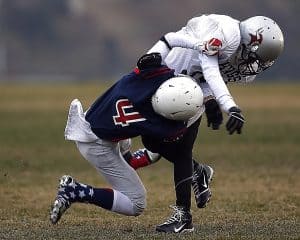[profileleft] [/profileleft]NFL fans understand that the risks involved with playing this violent game are extreme. We have heard the stories about players whose brains were severely injured while playing. The worst part of this is that we only found out about many of these brain injuries after the players had passed away at young ages. NFL traumatic brain injuries are a real concern for many people. Despite all of the learning that has occurred in recent years with regards to this troubling issue, there is still some uncertainty as to just how prevalent and problematic these brain injuries are. This is especially true in the “modern” game, as rules have been enacted to try to protect players from this type of trauma. According to a recent study, perhaps more changes are needed based on the results the researchers uncovered.
[/profileleft]NFL fans understand that the risks involved with playing this violent game are extreme. We have heard the stories about players whose brains were severely injured while playing. The worst part of this is that we only found out about many of these brain injuries after the players had passed away at young ages. NFL traumatic brain injuries are a real concern for many people. Despite all of the learning that has occurred in recent years with regards to this troubling issue, there is still some uncertainty as to just how prevalent and problematic these brain injuries are. This is especially true in the “modern” game, as rules have been enacted to try to protect players from this type of trauma. According to a recent study, perhaps more changes are needed based on the results the researchers uncovered.
About the Forthcoming NFL Traumatic Brain Injuries Study
A researcher from Florida State University and his colleagues completed the study. It has yet to be published. The researchers will provide an introduction to it at the upcoming American Academy of Neurology’s Annual Meeting. A news story describing the study is linked here. The researchers began by analyzing 40 retired NFL players. These players had a mean age of just under 36 years old, which means that a large number of them have played recently.
The researchers performed the following tests on the former players:
- Neurological history review and new examinations
- Neuropsychological evaluations
- Conventional MRIs using Diffusion Tensor Imaging, or DTIs
- Advanced MRIs using DTIs
The players’ careers lasted for an average of 7 seasons. They reported an average of 8.1 concussions during those playing careers as well as 12 sub-concussive hits. All of the players appeared normal based on their “basic” neurological exams. 17 of them, or more than 40 percent, suffered from some sort of abnormality based on the results of the DTI MRIs.
Specifically, the researchers found that the players struggled with the following:
- Attention
- Concentration
- Executive function
- Learning/memory
- Spatial/perceptual ability
The researchers also found that the longer a player’s career lasted, the more likely he recorded a positive DTI test. The same was not true for the more traditional testing.
What This All Means
The results of this study could prove to be yet another problem for the NFL. The league has already faced litigation more than once and has paid at least one enormous settlement. However, the study could also lead to additional testing for athletes who play a lower level of football and for other athletes who play sports that involve collisions. Traumatic brain injuries do not discriminate – any repeated head trauma can have long-lasting and severe effects.
Sadly, it may be too late to prevent traumatic brain injuries in those football players whose heads have already been exposed to such forceful and repeated punishment. Parents of children who are playing collision sports, however, do have an opportunity to look further into this problem. If your child suffers a head injury while playing sports, we hope that you would be extremely cautious before allowing him or her to return to competition. If you or someone you love has suffered head trauma because of the wrongful actions of someone else, contact a traumatic brain injury lawyer at Gomez Trial Attorneys for a free case evaluation.







